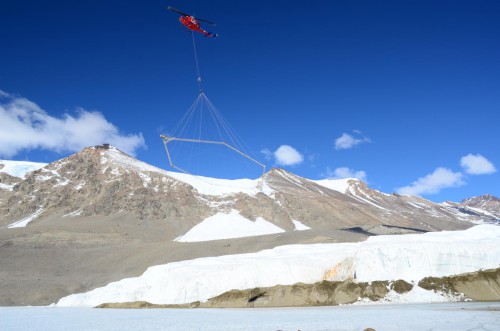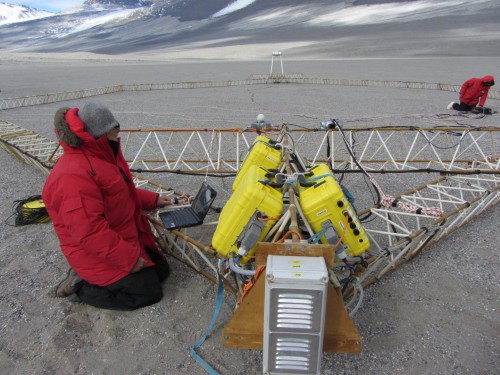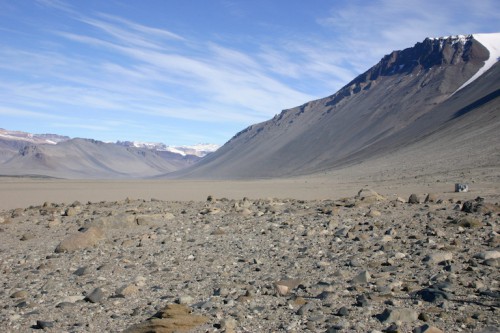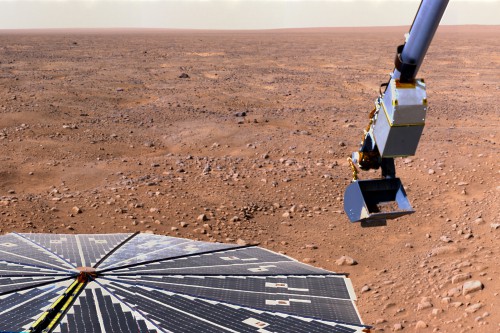
Scientists have discovered a vast network of salty aquifers beneath the surface of Antarctica, thanks to an airborne imaging system used there for the first time. The finding may have interesting implications for the search for life elsewhere, such as Mars, since it is known that, at least on Earth, a large variety of microscopic life forms can thrive in those kinds of environments.
Researchers from the University of Tennessee, Knoxville, and Dartmouth College made the discovery using SkyTEM, an airborne electromagnetic sensor. The system can detect and map otherwise unseen features below the icy surface, using an antennae suspended beneath a helicopter to create a magnetic field which can probe the subsurface to a depth of about 1,000 feet. Large areas of rugged terrain were able to be studied, thanks to the use of the helicopter.

The research is being funded by the National Science Foundation.
“These unfrozen materials appear to be relics of past surface ecosystems and our findings provide compelling evidence that they now provide deep subsurface habitats for microbial life despite extreme environmental conditions,” said lead author Jill Mikucki, an assistant professor at UTK. “These new below-ground visualization technologies can also provide insight on glacial dynamics and how Antarctica responds to climate change.”
Co-author Ross Virginia, a Dartmouth Professor, SkyTem’s co-principal investigator and director of Dartmouth’s Institute of Arctic Studies, added: “This project is studying the past and present climate to, in part, understand how climate change in the future will affect biodiversity and ecosystem processes. This fantastic new view beneath the surface will help us sort out competing ideas about how the McMurdo Dry Valleys have changed with time and how this history influences what we see today.”
The work is especially interesting to planetary scientists, since liquid water brines are thought to be possible for short times on the surface of Mars, and there may also be aquifers of water deeper down where there is more warmth. This would increase the chances that microscopic life could have existed, or may still exist, on Mars.

Underneath Antarctica it was found that the brines form extensive, interconnected aquifers below the surface, beneath glaciers and lakes with permafrost. The brines extend from the coast to at least 7.5 miles inland in the McMurdo Dry Valleys, which are the largest ice-free regions in Antarctica. They may be the result of freezing and/or evaporation of a large ancient lake or older ocean deposits. The fact that the lakes in the McMurdo Dry Valleys are now known to be interconnected rather than isolated is significant, since being connected helps to sustain ecosystems through times of climate change, such as lake dry-down events. The finding also shows that there is indeed liquid water, albeit salty, beneath the ice sheets where the pressure is below the melting point.
The same may be true for Mars, which in many ways resembles the Antarctic environment, in particular the McMurdo Dry Valleys, with freezing cold temperatures, permafrost, dry soil, and lack of vegetation. This location is considered to be one of the most Mars-like on Earth.
Specifically, SkyTEM took images of Taylor Valley along the Ross Sea which indicate that brines may exist there at temperatures as low as -68˚ F, including beneath lower Taylor Glacier. Blood Falls, an iron-rich brine that seeps out of the glacier, is already known to host an active microbial ecosystem. Extremophile organisms have no problem living in these conditions.
Since there are also known to be ancient glaciers on Mars, similar conditions may exist below them as well, which could be capable of still supporting microscopic life. The Mars Phoenix Lander landed on permafrost terrain near Mars’ north pole, with similar conditions to Antarctica. The lander scooped up water ice deposits; might there be brines deeper down? Odd “droplets” seen on one of the lander’s legs after landing are thought to have possibly been brine which splashed onto the leg after landing engines heated the soil. The Curiosity rover also recently found evidence that brines may be common on Mars. Liquid water, even salty water in very limited amounts, could theoretically help microbes to survive in Mars’ hostile environment. The Recurring Slope Lineae (RSL) dark streaks on many equator-facing slopes may be brines briefly flowing on the surface. Common in the summer, they may originate from either melting ice or subsurface aquifers. If they are brines, it would be the first time liquid water has been seen on the surface of another planet.

Besides Mars, there are other places where these findings might be pertinent, such as small icy moons like Europa and Enceladus. They also resemble Antarctica in that they are ice-covered worlds with liquid water beneath the surface. That water, an entire ocean of it on both moons, is salty and similar to sea water on Earth. On Enceladus, the water makes its way to the surface through huge cracks, spewing into space as geysers of water vapor. The Cassini spacecraft has directly sampled some of those plumes, finding water vapor, ice particles, salts, and organic material. Both moons are now considered to be prime candidates in the search for evidence of life elsewhere in the Solar System. There may also be subsurface water on other moons as well, including Titan and Ganymede, among others.
The SkyTEM discovery in Antarctica not only provides new insight into how life can exist in extreme conditions here on Earth, it also helps to show how life might be possible in similar kinds of environments elsewhere in the Solar System or even beyond. As the saying goes, “follow the water,” even if it is a bit more salty than desired.
The study was published in the journal Nature Communications.
Want to keep up-to-date with all things space? Be sure to “Like” AmericaSpace on Facebook and follow us on Twitter: @AmericaSpace




“Besides Mars, there are other places where these findings might be pertinent, such as small icy moons like Europa and Enceladus. Both moons are now considered to be prime candidates in the search for evidence of life elsewhere in the Solar System. There may also be subsurface water on other moons as well, including Titan and Ganymede, among others.”
As a follower of Gerard K. O’Neill, I completely disagree with Mars as “the horizon goal.” The reality is that Mars is a gimmick- a public relations device used to garner public support. Anyone who wants to “live” on Mars has in my view proven the old saying,”there’s a sucker born every minute.” The zeitgeist phrase “multi-planet species” is actually a oxymoron; only one planet has the environmental conditions our species evolved in. The path to insuring species survival is creating artificial Earth environments in space with mega-habitats. That NewSpace uses Mars as a tool for deluding the gullible is no surprise considering they are just following NASA’s lead in pandering to whatever brain candy journalism and click-bait the public will consume. Cloud cities on Venus.
The possibility of living oceans under the surface of the gas giant moons make Mars a poor destination for explorers. This truth is slowly beginning to dawn despite a lack of exposure. The false perception that Mars is somehow “just close enough” to get to on the cheap is also slowly being exposed as SLS/Orion progresses and the reality of space radiation becomes undeniable. Only nuclear energy can propel a spinning, massively shielded spaceship Beyond Earth and Lunar Orbit (BELO). There is no sending a single craft into the void without a back-up available for a rescue mission- we learned that with Columbia. As a former Search And Rescue aircrewman I can testify to how stressful it becomes when there is no airplane to back up the one that goes out on a dark and stormy. In practice this means a small fleet of atomic spaceships is required for any interplanetary travel. With such a fleet Mars becomes the place to bypass in favor of far more interesting and easy-to-land-on destinations. We also have fully matured research submersible technology.
Such a fleet is possible as a means of replacing the aging strategic nuclear forces (unavoidable) by relocating the nuclear deterrent into deep space and also safeguarding the planet from asteroid and comet impact threats. A way to defray the cost of this fleet is to begin by assembling Super Heavy Lift wet workshop space stations in lunar “frozen” polar orbits. After having their radiation shields filled with water-derived-from-lunar-ice these stations can transit back across cislunar space into GEO and replace the satellite junkyard, thus capturing the over 100 billion dollar revenues of that industry. Dock a propulsion system to the space stations under construction in lunar orbit and they become spaceships.
The only place outside the magnetosphere to acquire water-as-radiation-shielding, assemble, test, and launch nuclear missions is the Moon. LEO is the worst place to go and in terms of interplanetary travel this dumps the NewSpace business plan in the trashcan.
“Wright Valley in the McMurdo Dry Valleys of Antarctica; the environment in these valleys is very similar to Mars.”
I have to disagree.
Perhaps it is a poor choice of words by the author (one can always argue about the application of subjective descriptions like “very similar”), but there is no arguing that for decades experts in the field have considered these dry valleys of Antarctica to be among the best analogs for the martian environment that exist on Earth.
I just argued McMurdo Dry Valleys of Antarctica are not “very similar to Mars.”
Do not involve me in your “no arguing” argument, thank you. If you continue to reply to my comments in this manner instead of making your own separate comment I am going to complain to the editor. I will not let you harass me without calling it what it is. You need to rethink your life after the last string of inappropriate replies you made.
I’m unaware that there is not a “do not reply to comments by others” policy on this web site. My comment was polite, factual and on topic. Please stop reacting with hostility to every comment.
You have tried to have me banned from this site, you have repeatedly mocked me, made disparaging remarks, and put words in my mouth. YOU are a bully. I will not let you keep replying negatively to all my comments without exposing why you are doing it and what you are Andrew- every time. You can plead with me to stop reacting with hostility but what you need to do is leave me alone- it’s that simple. If you cannot do that- then you are proving that YOU have the problem.
I have most certainly not made any attempt to ban you from this nor any other site. I wouldn’t waste my time contacting the moderators of any web site with such trivia. I will also not be bullied by you or any other poster into not making comments that follow the site’s established posting policies. And if my comments express opinions that do not coincide with yours or present facts that do no conveniently fit into your narrative, that’s no excuse for hostility. If you do not like what I have to say, then you can chose not to read or reply to it. If you have a problem with this, feel free to contact the moderator(s) of this site and I will be more than happy to defend my posts on this site.
Until the day the moderators institute a special “do not reply to Gary Church” policy, I will continue to post on-topic replies to your comments that follow this site’s posting policies if I and when I chose to do so. For fear of potentially violating this site’s policy of straying too far off topic, I am done addressing this issue. Feel free to do as you wish.
“I have most certainly not made any attempt to ban you from this nor any other site.”
You are a liar. That you veiled the attempt in language designed to allow you to deny it is despicable. Creating a toxic environment of constant negative replies did not work so you conspired with others with implied legal action against this site because of my “hostility.” Yes, that is your word.
No you refuse to stop bullying me and call me the abuser. You will not leave me alone after I have repeatedly warned you that your replies to my comments were inappropriate. Now you are the offended party and hide behind “website policy” to allow you to keep cyberstalking me. You are disgusting.
“I will continue to post on-topic replies to your comments that follow this site’s posting policies if I and when I chose to do so-”
And I will continue to expose you as a bully and a liar every time you do.
If you have an issue, bring it up with the moderators. PLEASE!
I did. Regardless of what he decides, every time you try and play your sick game with me I am going to throw it in your face- every single time. So just leave me alone and none of that will be necessary.
I forgot to mention before, but yeah maybe not the best description. 😉 What I meant is that places like McMurdo and Atacama are the closest analogs we have on Earth to Mars. Still significant differences though.